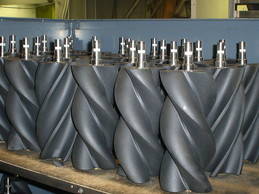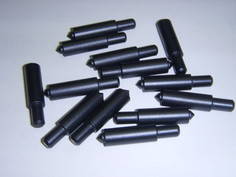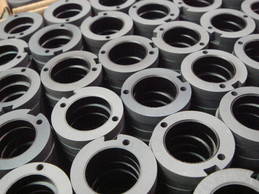 Every mechanical device we encounter is made up of separate parts that all must fit together, moving simultaneously in a cohesive group. During the manufacturing process, sometimes parts experience small dimensional variations – as such, engineers design parts with built-in tolerances to accommodate those variations. These tolerances are a range of measurements, determined by the engineer, into which the manufactured parts may ultimately fall, so as to still function properly when inserted into the final machine or device. When parts are too large or small to fit together, the entire device fails.
Every mechanical device we encounter is made up of separate parts that all must fit together, moving simultaneously in a cohesive group. During the manufacturing process, sometimes parts experience small dimensional variations – as such, engineers design parts with built-in tolerances to accommodate those variations. These tolerances are a range of measurements, determined by the engineer, into which the manufactured parts may ultimately fall, so as to still function properly when inserted into the final machine or device. When parts are too large or small to fit together, the entire device fails.
Achieving tight tolerances – the tighter, the better
When determining tolerance limits for a part, it’s important to set limits that will not affect the other components that make the finished product work. The more precisely the parts fit when assembled, the more efficient and reliable functionality you can expect from the machine. Thus, it is always in the best interest of any manufacturer to conform to the tightest tolerance possible, which translates to producing parts with the best possible fit.
 In mechanical systems involving several parts, each part will be designed with its own tolerance limit. As a result, during the design process, engineers need to account for the potential dimensional variation of each individual part, which leads to an accumulation of tolerances along the entire assembly – also known as tolerance stacks. These stackups of potential structural variances are the reason that tight tolerances are so important. The tighter the tolerance is on each individual component, the higher the quality and dependability will be on the finished product.
In mechanical systems involving several parts, each part will be designed with its own tolerance limit. As a result, during the design process, engineers need to account for the potential dimensional variation of each individual part, which leads to an accumulation of tolerances along the entire assembly – also known as tolerance stacks. These stackups of potential structural variances are the reason that tight tolerances are so important. The tighter the tolerance is on each individual component, the higher the quality and dependability will be on the finished product.
Conforming to tighter tolerances requires precision manufacturing and a thorough inspection process, but results in massive overall cost savings. When tolerances are tight, finished parts, including those with industrial coatings, are easy to assemble and require minimal adjustment, which is particularly important when the mechanical system is complex. By being accurate and ready for assembly upon completion, the cost of labor drops significantly. With a more precise fit, there is less risk of jamming, slipping, or any other malfunction that can not only damage the reputation of the manufacturer, but can also lead to costly warranty claims from the end-user.
How do industrial coatings factor into tolerances during manufacturing?
One effective, cost-efficient, yet often overlooked way of overcoming the challenges of stacked tolerances in industrial and mechanical applications is through the use of dry lubricants such as resin-bonded PTFE (polytetrafluoroethylene). If manufactured parts fit together too tightly after assembly, the key to the machine’s functionality lies in the addition of a dry lubricant coating. Applying a coating to the parts reduces the coefficient of friction on their surfaces – as such, they are able to easily slide over each other or rotate freely. Conversely, if the parts fit together too loosely, a reasonably thick coating may be added to increase the dimensions of the part. Both processes make operative performance viable for machines that would otherwise fail.
 Moreover, a part may require a low-friction coating simply as part of its standard design. It is important that the industrial coating service is applied in such a way that its thickness falls into the tolerance limit determined by the engineer. If the industrial coating thickness falls above or below the established tolerance, the part will not fit. Therefore, finding a coatings applicator that can abide to strict, tight tolerances with micron-accuracy is crucial to the success of the completed instrument.
Moreover, a part may require a low-friction coating simply as part of its standard design. It is important that the industrial coating service is applied in such a way that its thickness falls into the tolerance limit determined by the engineer. If the industrial coating thickness falls above or below the established tolerance, the part will not fit. Therefore, finding a coatings applicator that can abide to strict, tight tolerances with micron-accuracy is crucial to the success of the completed instrument.
An example of where tight tolerances come into play can be found in the automotive industry, on parts like bearings and shafts, such as those processed by Orion Industries. These parts require industrial coatings in order to function smoothly within a vehicle’s complex mechanical system, and maintaining tight coating tolerances not only causes the parts to fit better for assembly, but also prevents problems such as small air leaks that can create a rattle and affect the efficiency of the car’s computer. Orion Industries has developed automated technology that regulates the thickness of all industrial coating services and applications for automotive parts every day. Due to ever-improving application techniques and a rigorous quality process, Orion does not see returns on parts due to coating thickness requirements.